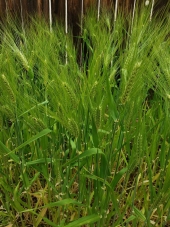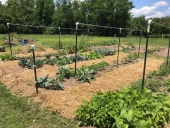posted 9 years ago
My heads of barley have 20 to 24 seeds per head. That happens to be the same amount of seed that is the optimal planting density for a square foot of soil.
Preventing the seeds drying out during germination is key, as is some contact with the soil so the roots can get in there. This could be achieved with straw mulch Fukuoka style.
The biggest challenge is dislodging the seeds and dispersing them. Small grains were originally chosen for agriculture because they contain a genetic defect that prevents the seed head from shattering. Under natural conditions, this is a distinct disadvantage because the seeds don't disperse. However, it does mean that people can harvest the seed without losing it all over the place as soon as it's moved.
If you are to simply drop a seed head on the ground (or bury it) then you will not end up with a very good result at all. I'm saying this because last growing season I planted very densely because I didn't have enough space for all my seed. I ended up with half the amount I started with. Repeat that a few times and you end up with nothing...
Planting a seed head is like planting a square foot worth of seed in only 4 square inches. The seeds are so densely planted, that only 2 or 3 out of 20 are going to survive to maturity (ignoring other factors like predation). Under good conditions, a plant will put out three seed heads. But I found that under densely planted conditions, they only put out one., if anything at all. So a planted seed head is likely to produce an equivalent yield of 1, maybe 2 seed heads (of lower quality than the original as they will be much smaller seeds).
IMHO, the additional energy required to break the seed head apart before planting is well worth the effort. Even using the most primitive methods, the calorific gains far outweigh the calorific input.









